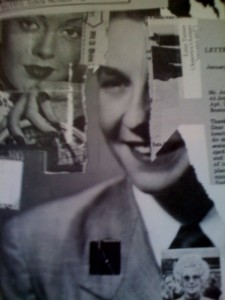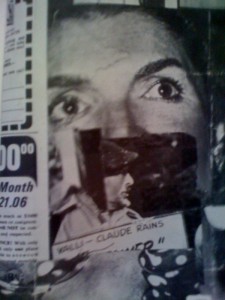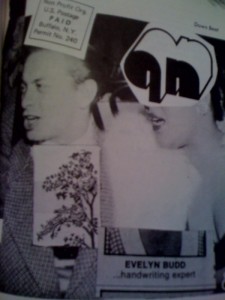Behind the State Capitol: Or Cincinnati Pike
BY Cedar Sigo

John Wieners' Behind the State Capitol: Or Cincinnati Pike was printed by Good Gay Poets out of Boston in December 1975. It is described by Wieners on its title page as “A collection of poetry written by John Wieners in the The United States. Cinema decoupages; verses, abbreviated prose insights.” It feels appropriate to be discussing this book under the heading of craftwork, as so many of its finest attributes, (voice, velocity and variety) have found their way into not just into my own work but also that of my contemporaries. Julian Brolaski, David Larsen, Micah Ballard, Sara Larsen, Michael Carr, Rob Halpern and CA Conrad come to mind.
THE LIGHTS IN TOWN
Not as bad as you are
And the next time that I see you
I shall be old, a figure
Crouched from under aquaducts
Where you still remain a broad a silent
jet plane openly bound across velvet seas.
Stuck in town myself, to go back
for years on aird, rugged paths
Poetry appears that sure entrance to a
storied paradisical garden, where pure
patented mystique fufills its indispensible acts
your passion's kiss maintained against our age.
The book comes to two hundred and two pages. Its small and clinical font is more that of a brochure than a collection of poetry. The book also features several collages by Wieners. They work well with the poetry to see the reader through its concurrent and chronic dissemblance of syntax. The same jagged line is employed but made manifest in a visual format, The collages seem to have been done quickly for maximum impact, and the edges are not perfectly (if at all) trimmed. They barely want to be held together. Their content is like that of the poetry, in that much of it pours over John's past. There are newspaper clippings devoted to readings in Buffalo and the death of Charles Olson, as well as numerous articles from Hollywood fan magazines: “Comeback Hopes High For Yvonne De Carlo.” A Carl Van Vechten portrait of Billie Holiday is left alone and intact. Subtle (and effective) disfigurement is made to '70s gay pornography. One boy's head is pasted perfectly backward so both his face and ass are turned to the viewer. He is being strangled with the tip of a whip.

sired hero's mind. Neon kings blind SsiS
witness Irving Wallace, an Idol crew nook
spoken portrait exhibited falcon maltese puke
for sake of disaster, bogus DC show carcass.
Float electrified currency city headline,
a mother's memory should ax pier slaughter,
together on 10th Avenue twin Caroline star routine
as good as tomorrow's edition in gold Jenifer.
(from “Faren Ferries”)
Throughout the book, the center of each line gets thrown up into the air just to see what memory reflects and to interrupt its bounding forward. The capital letters are intermittent and work as planks or stuffing -- feathers! There is a music in this hacking away, a relentless splintering of Wieners' favorite imagery: elevators, hallways, Boston Common, movie stars. Sometimes the bits of images are run together like torn film of a boardwalk or bowery, or sometimes the seams are shown most obviously, like piecemeal wallpaper. The prose pieces are more like nests than flat collage, more like something clinging to a wall. Certain words are always crowded out at the end of each line. These remaindered words are often the most hilarous sticking points.
“intravenously Axis to appelate Bakersfield arbors. Noxious under
the moon, or noon
Fitzgerald, arisen
out of Continental bathprison, Central Islip State and Taunton
to hold each person Barbizon.”
(from “To The Bad Debts In The United States Depts.Of The Treasury. Secret Service Duration”)
Not all of the work is so manic. There are several entire poems that recall the earlier style of Nerves (1970), The Hotel Wentley Poems (1958), and Ace of Pentacles (1964). Then others are shadowed and narrative, drawing us I,n only to be “ruined” by a new overarching interference. I keep thinking of a taser. If this is evidence of Wieners' “madness,” I can only confess that I've always delighted in its insistence here.
There are also older masterworks revisited and given facelifts – or eyes without a face, really, as they are seldom “improved.” The mix of Wieners' already revered lyric line next to these constantly interrupted prose works keeps a devoted reader alert. I have always had the same feeling reading Jack Spicer, namely that the second you expect him to come on a certain way, he very naturally defies your expectations. “Children of the Working Class” could be the classic extant symbiosis of all these styles. It is political in tone, autobiographical, and was written in 1972 during a stay at Taunton State Hospital. Its line does sprint in places, but is never cut for the sake of cutting to gain its measure.
...housed of course
and there fed poorly
off sooted, plastic dishes, soiled grimy silver knives and forks,
stamped Department of Mental Health spoons
but the unshrinkable duties of any society
produces its ill-kempt, ignorant and sore idiosyncrasies
There has never been a man yet, whom no matter how wise
can explain how a god, so beautiful he can create
the graces of formal gardens, the exquisite twilight sunsets
in splendor of elegant toolsmiths, still can yield the horror of
dwarfs, who cannot stand up straight with crushed skulls,
diseases on their legs and feet unshaven faces and women,
worn humped backs, deformed necks, hare lips, obese arms
distended rumps, there is not a flame shoots out could ex-
tinquish the torch of any liberty's state infection.
Behind the State Capital was put together with considerable assistance from the poet and gay activist Charles Shively. He has written of this process:
The “Table of Contents” was John's work, but I tried to sort out the poems into discrete entities, little jewels, when they were not that at all, but part of a lifelong web strung together in a singular and erratic rhythm. When John read at St. Mark's Church in 1968, he read by jumping within the book from poem to poem -- taking a part from here, another part there, and weaving them together for a singular performance.
The shift in John's work toward a more fervent gay activism is often credited to his attending the 1972 Miami Democratic National Convention, with, among others, Allen Ginsberg. He was a contributing writer throughout the seventies for many of the emerging queer underground papers including Fag Rag, Gay Sunshine, and possibly even Straight to Hell.

Invariably, talk has come up around the idea of a Collected Wieners, and what with A Book of Prophecies being discovered a few years back (and published in 2007), just how the book would be assembled, what should be left in and out. I believe that Behind the State Capitol is the book that casts so many questions over his life's work. It cannot be excerpted to anyone's true satisfaction, due in no small part to its many collages. It would have to be printed as its own separate volume.
These days poetry seems to be in dire need of delusion anyway. Especially here, as it's laid out so pleasurably, across pages. To be adept at several styles and have them surface as needed was once an ultimate goal of mine as a writer. Now I don't think of it as having several styles, but having a lot of voices available. Thinking in terms of voices eliminates that quality of anything being strived for – the term “style” sounds a bit after the fact. I have spent so much time reading Behind the State Capitol in preparation for writing this that I am beginning to hear everything in its inimitable register. These are not the sort of changes every poet can pick up on, let alone make use of.
“The piano renditions and the professional involvement are
hopeful. Fresh flowers and irrelevant artifacts, pre-Hunter and
Merrick caution retaliations too venomous to harness with words,
so back to the believable histrionics without drugs, but with
some trace of them in the dives' discharges.”
(from “Torch Song”)
Poet Cedar Sigo was raised on the Suquamish reservation near Seattle, Washington, and home schooled ...
Read Full Biography

